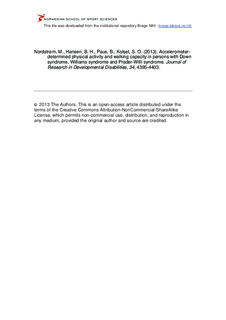Accelerometer-determined physical activity and walking capacity in persons with Down syndrome, Williams syndrome and Prader-Willi syndrome
| dc.contributor.author | Nordstrøm, Marianne | |
| dc.contributor.author | Hansen, Bjørge Herman | |
| dc.contributor.author | Paus, Benedicte | |
| dc.contributor.author | Kolset, Svein Olav | |
| dc.date.accessioned | 2014-03-18T09:36:01Z | |
| dc.date.available | 2014-03-18T09:36:01Z | |
| dc.date.issued | 2013-10-18 | |
| dc.identifier.citation | Research in Developmental Disabilities. 2013, 34, 4395-4403 | nb_NO |
| dc.identifier.uri | http://hdl.handle.net/11250/192518 | |
| dc.description | © 2013 The Authors. | nb_NO |
| dc.description.abstract | In this study we describe by use of accelerometers the total physical activity (PA), intensity pattern and walking capacity in 87 persons age 16–45 years with Down syndrome (DS), Williams syndrome (WS) and Prader–Willi syndrome (PWS). Participants were recruited from all over Norway, and lived either with their parents or in community residences with support. On average the participants generated 294 counts per minute (cpm) or 6712 steps per day, with most of the day spent in sedentary activity, 522 min/day, followed by 212 min/day in light PA, 71 min/day in lifestyle activity and 27 min/day in moderate-to-vigorous physical activity (MVPA). Inactivity was prevalent, as only 12% meet the current Nordic recommendations for PA. When compared, no differences for total physical activity or time in MVPA were observed between the three groups. However, participant with DS spent a mean of 73 min/day less and 43 min/day less in sedentary activities compared to participants with PWS and WS, respectively, (p = 0.011, 95% CI: −10.9; −80.1). In addition the DS-group spent a mean of 66 min/day more in light PA than the PWS-group and 41 min/day more than the WS-group, (p < 0.001, 95% CI: 29.3; 79.7). Participants with PWS spent on average 30 min/day less in lifestyle activities compared to both participants with DS and WS, (p < 0.001, 95% CI: −14.2; −45.4). No association between total PA and BMI were observed. Males were more active than females across all diagnoses. Males accumulated on average 85 counts per minutes more than females, (p = 0.002, 95% CI: 33.3; 136.7), 2137 more steps per day, (p = 0.002, 95% CI: 778; 3496). The mean walking capacity during six-minutes was 507 m (SD 112 m) for males and 466 m (SD 88 m) for females. Distance walked during testing decreased with 33.6 m when comparing normal or underweight participants to overweight participants, and 78.1 m when comparing overweight to obese participants (p < 0.001 95% CI: −40.4; −85.8). When adjusted for BMI no differences in walking capacity between the three genetic conditions were observed. | nb_NO |
| dc.language.iso | eng | nb_NO |
| dc.publisher | Elsevier | nb_NO |
| dc.subject | VDP::Medisinske Fag: 700 | nb_NO |
| dc.subject | accelerometer | nb_NO |
| dc.subject | physical activity | nb_NO |
| dc.subject | six-minute walk test | nb_NO |
| dc.subject | Down syndrome | nb_NO |
| dc.subject | Williams syndrome | nb_NO |
| dc.subject | Prader–Willi syndrome | nb_NO |
| dc.title | Accelerometer-determined physical activity and walking capacity in persons with Down syndrome, Williams syndrome and Prader-Willi syndrome | nb_NO |
| dc.type | Journal article | nb_NO |
| dc.type | Peer reviewed | nb_NO |
| dc.source.journal | Research in Developmental Disabilities | nb_NO |
| dc.identifier.doi | 10.1016/j.ridd.2013.09.021 | |
| dc.description.localcode | Seksjon for idrettsmedisinske fag / Department of Sport Sciences | nb_NO |
Tilhørende fil(er)
Denne innførselen finnes i følgende samling(er)
-
Artikler / Articles [2096]
